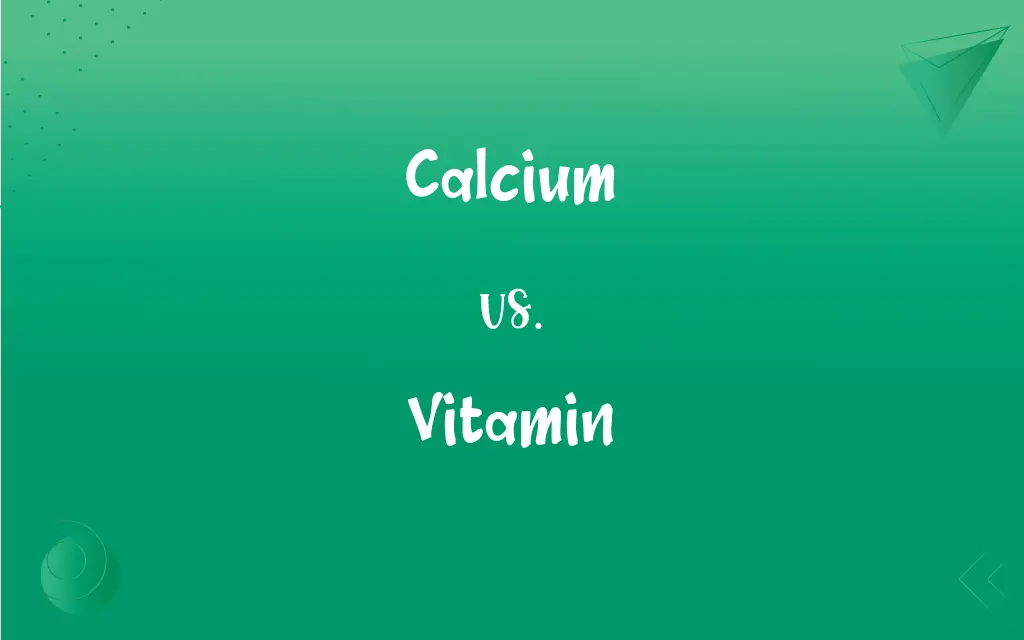Calcium vs. Vitamin: What's the Difference?
Edited by Aimie Carlson || By Harlon Moss || Updated on October 22, 2023
Calcium is a mineral vital for bone health, while vitamin refers to a group of organic compounds essential for body functions.

Key Differences
Calcium is a chemical element and a vital mineral found in various foods. It plays a critical role in building and maintaining strong bones and teeth. On the other hand, a vitamin is an organic molecule that the body needs in small amounts for its metabolic processes. Vitamins are not synthesized in adequate amounts by the body, which means they must be obtained from the diet.
Calcium not only supports skeletal structure but also assists in muscle function, nerve transmission, and blood clotting. Vitamins, however, are diverse in their functions. They participate in energy production, immune function, blood clotting, and various other processes, depending on the specific vitamin in question.
Dietary sources of calcium include dairy products, leafy green vegetables, and fortified foods. In contrast, vitamins are found in various food sources depending on their type. For example, vitamin C is abundant in citrus fruits, while vitamin D can be obtained from sunlight and certain fatty fish.
Too little calcium intake can lead to weakened bones, increasing the risk of fractures. Similarly, a deficiency in certain vitamins can lead to specific diseases or disorders. For instance, a deficiency in vitamin C causes scurvy, while a lack of vitamin D can result in rickets in children.
Both calcium and vitamins are crucial for overall health. To ensure adequate intake, it's essential to consume a balanced diet rich in whole foods. Supplements can also be taken if recommended by a healthcare professional, but they should not replace a well-balanced diet.
ADVERTISEMENT
Comparison Chart
Nature
An inorganic mineral.
Organic compounds.
Primary Role
Strengthens bones and teeth.
Supports various bodily functions (energy production, immune response).
Dietary Sources
Dairy products, leafy greens, fortified foods.
Varies (e.g., citrus fruits for vitamin C, fatty fish for vitamin D).
Deficiency Diseases
Osteoporosis, rickets.
Scurvy (vitamin C), beriberi (vitamin B1), rickets (vitamin D).
Overconsumption Risks
Kidney stones, hypercalcemia.
Toxicity varies by type (e.g., hypervitaminosis A, hypervitaminosis D).
ADVERTISEMENT
Calcium and Vitamin Definitions
Calcium
A mineral crucial for bone health.
Dairy products are rich in calcium.
Vitamin
Divided into water-soluble and fat-soluble types.
Vitamin K is a fat-soluble vitamin involved in blood clotting.
Calcium
Important in nerve transmission.
Adequate calcium ensures effective nerve communication.
Vitamin
Aids in various functions from energy production to immunity.
Vitamin B12 is crucial for nerve function.
Calcium
An element represented by the symbol Ca.
Calcium reacts with water to produce hydrogen gas.
Vitamin
An organic compound essential for metabolic processes.
Berries are packed with vitamin C.
Calcium
A key factor in muscle contraction.
Proper calcium levels are essential for heart function.
Vitamin
Intake deficiencies can lead to specific diseases.
Vitamin A deficiency can cause night blindness.
Calcium
Essential for blood clotting processes.
Calcium plays a role in converting prothrombin to thrombin.
Vitamin
Necessary for the body but not produced in adequate amounts.
Vitamin D is synthesized when the skin is exposed to sunlight.
Calcium
A silvery, moderately hard alkaline-earth metal that constitutes approximately 3.6 percent of the earth's crust and is a basic component of most animals and plants. It occurs naturally in limestone, gypsum, and fluorite, and its compounds are used to make plaster, quicklime, Portland cement, and metallurgic and electronic materials. Atomic number 20; atomic weight 40.08; melting point 842°C; boiling point 1,484°C; specific gravity 1.54; valence 2. See Periodic Table.
Vitamin
Any of various fat-soluble or water-soluble organic substances that are essential in minute amounts for normal growth and activity of living organisms. They are synthesized by bacteria and plants and are obtained by animals chiefly in their diet.
FAQs
What is calcium primarily known for?
Calcium is primarily known for its role in strengthening bones and teeth.
Can the body produce enough calcium on its own?
No, calcium must be obtained from dietary sources.
What happens if I have a calcium deficiency?
Calcium deficiency can weaken bones, increasing the risk of fractures.
Are all vitamins organic compounds?
Yes, vitamins are organic compounds essential for various body functions.
What foods are rich in calcium?
Dairy products, leafy green vegetables, and fortified foods are rich in calcium.
Is excessive calcium intake harmful?
Yes, excessive calcium can lead to kidney stones and hypercalcemia.
What disease results from vitamin C deficiency?
Vitamin C deficiency leads to scurvy.
Why is vitamin A essential for vision?
Vitamin A helps form the light-sensitive receptors in the eyes.
Why are vitamins crucial for the human body?
Vitamins support various bodily functions, including metabolism, immunity, and energy production.
Can the body synthesize vitamins in sufficient amounts?
No, most vitamins must be obtained from dietary sources as the body doesn't produce them in adequate amounts.
How does calcium benefit muscle function?
Calcium plays a key role in muscle contraction.
What role does vitamin D play in the body?
Vitamin D aids in calcium absorption and bone health.
Can I get calcium from plant-based sources?
Yes, foods like leafy green vegetables and almonds contain calcium.
How does calcium support nerve function?
Calcium is essential for effective nerve transmission.
What is the main difference between calcium and vitamins?
Calcium is an inorganic mineral, while vitamins are organic compounds.
Are there different types of vitamins?
Yes, vitamins are categorized into water-soluble and fat-soluble types.
Is calcium involved in blood clotting?
Yes, calcium plays a role in various stages of the clotting process.
Which vitamin is crucial for blood clotting?
Vitamin K is essential for blood clotting.
Can excessive vitamin intake be harmful?
Yes, overconsumption of some vitamins can lead to toxicity and adverse effects.
Are calcium supplements safe?
Calcium supplements can be safe when taken as directed, but it's essential to consult a healthcare professional before starting any supplement regimen.
About Author
Written by
Harlon MossHarlon is a seasoned quality moderator and accomplished content writer for Difference Wiki. An alumnus of the prestigious University of California, he earned his degree in Computer Science. Leveraging his academic background, Harlon brings a meticulous and informed perspective to his work, ensuring content accuracy and excellence.
Edited by
Aimie CarlsonAimie Carlson, holding a master's degree in English literature, is a fervent English language enthusiast. She lends her writing talents to Difference Wiki, a prominent website that specializes in comparisons, offering readers insightful analyses that both captivate and inform.
































































